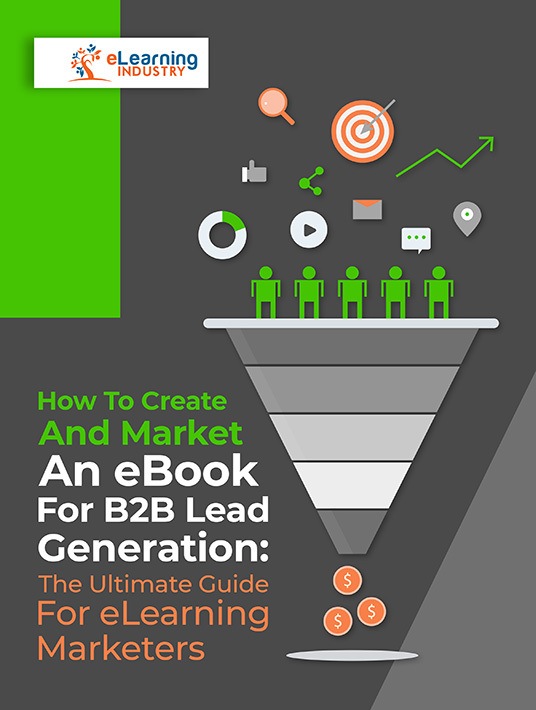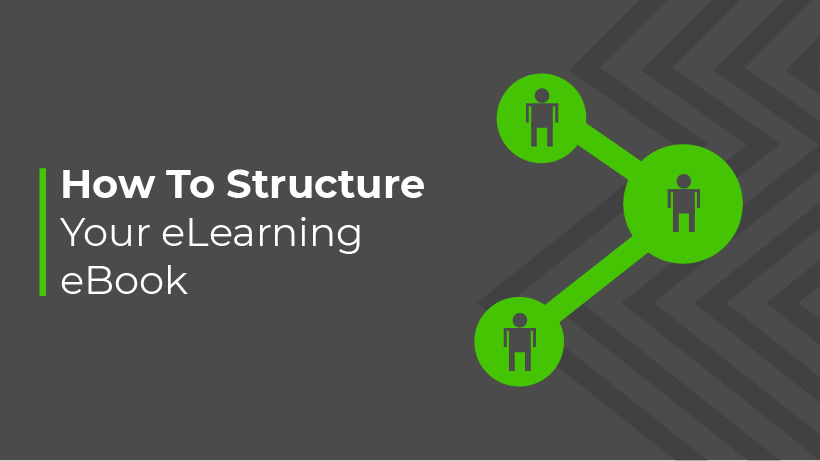5 Ways To Structure Your eLearning eBook For Effective Lead Generation
The more care you dedicate to crafting your eBook and the more strategic you make it, the more useful the content will be for your audience. This means that the amount of time and effort you put into its creation will directly impact just how often people download it.

In order to maximize the impact, and the number of downloads of your eBook, you have to look at it through the eyes of your audience [1]. What are they most concerned about, and what information would be most valuable to them in that context? Where are they in the sales funnel? Based on that, should your eBook serve as a research tool for them or a shopping guide?
Premium, high-quality content is meant to carry value far beyond the eBook itself. Whatever the messages and ideas are in your content, the most important thing to do is make it consistent. Achieving that consistency will involve carefully and strategically structuring your eBook to generate leads.
Laying The Foundation Of Your eLearning eBook
eBooks are premium, long-form content. Hence, it'll be more of a challenge to keep your content on message and consistent throughout. Especially if it's written haphazardly and without a plan. Follow these tips to structure your eBook in a way that helps you overcome this challenge and ensures your content is as engaging and meaningful as possible.
1. Make The Title Clear, Optimized, And Noticeable
The title is the first thing readers see. It has to be eye-catching enough to make them want to read more. You want it to grab the attention of anyone who might benefit from your eBook.
As you write your title, optimize it for search engines so people beyond your immediate audience can easily find it [2]. This will require plenty of SEO research on your topic to better understand what readers in this space are searching for. Once you know that, it will allow you to choose the most effective keywords to keep front-and-center in your title. The front is the most important, as placing keywords at the beginning can you help you rank higher in search.
You should also make sure the keyword phrase you choose is relevant to your target persona. For example, the title "The Ultimate Employee Training And Development Guide For L&D Managers" would appeal to the persona of Learning and Development managers. This optimization strategy can help eLearning companies attract the right leads and avoid irrelevant user profiles.
Above all else, it’s important that your title be clear [3]. You want it to directly represent what readers will find when they give you their email addresses to access it. This will help you set expectations upfront and stick to them throughout the content.
2. Outline Your Chapters In Great Detail
Unlike a blog article or social media post, your audience has to give you some form of information in order to read your eBook. This is no small thing. You want readers to feel like it was worth the trade, so your content should provide as much value as possible.
Establish a structure for your eBook by outlining its chapters and then filling in the finer details [4]. Not only does this give you an idea of how your content will flow, but it also keeps you from babbling on about one topic for too long. Divide the subject into as many chapters as you need. As long as they highlight the information in a comprehensive but succinct way. Your eBook can include anywhere from 3 chapters to 13.
Once you have the outline in place, you can further build out each topic and then work to ensure each idea flows smoothly into the next [5].
3. Keep The Chapters Skimmable
Make sure you don't end up with blocks of text that feel bulky and tedious to read. If you do, readers might close the eBook as quickly as they open it and, even worse, regret that they shared their personal information to access it at all. Embrace the fact that most people skim content for information that’s relevant to them, which should drive you to keep your chapters brief.
However, don't use that as an excuse to skimp on content. The most successful eBooks are those that deliver the maximum amount of information in the most easily digestible formats. Use simple font schemes, and keep them consistent throughout. Break paragraphs up into bullet points and subheadings that guide the readers. Link back to pages. Especially in the table of contents, so readers can navigate the eBook for reference more easily.
4. Add Strategic Eye-Catchers
A good title catches your audience’s eye, but it’s just the hook. Keep readers’ attention by including plenty of illustrations, diagrams, charts, photos, and infographics that complement your written content. If a page has statistics, make the most relevant ones stand out as charts or graphs. Similarly, use pull quotes to bring immediate attention to the catchiest phrases in the text.
Like every element of your eBook content, the best graphics are those that serve a purpose, so be strategic when choosing the right ones. Use the space to illustrate complex points and give readers a visual to associate with the points you’re making. Besides being visually appealing, the images will also leave readers with a clear, lasting impression of the information you present. When done correctly, it also leaves you room to sprinkle in images that are directly related to your brand.
5. Brand Your eBook Only When It Makes Sense
The greatest value your eBook provides to readers is information. If it looks more like an advertisement than an eBook, your audience won’t be receptive to it. You can still brand it with your logo and colors in a way that isn’t overly promotional but clearly ties your brand to the content's value. For example, consider subtly using your brand’s color palette and the same font as you do in other content you offer throughout the eBook.
Placing your logo throughout the eBook can also be a good strategy, but keep in mind that it can be tricky to do so in an unobtrusive way. If it’s too prominent and shows up too often, its presence could dilute the eBook's value for some readers. Instead, try placing a small logo in the corner of each page, where it isn’t obvious but is likely to be seen at least a few times.
If you want to create an eBook that's going to generate B2B leads, rank well in search, and genuinely engage the readers who download it, take the time to strategically plan it. Not only will this allow you to create more thoughtful, helpful content, but it will also ensure that readers feel glad they shared their email addresses with you in the first place.
eLearning marketers may sometimes feel overwhelmed when they’re in the process of finding the best ways to create and market an eBook for B2B lead generation. Download our free eBook How To Create And Market An eBook For B2B Lead Generation: The Ultimate Guide For eLearning Marketers to discover how to create and market a B2B lead generation eBook that addresses the topic with the authority of an eLearning marketing expert but in a friendly tone.
References:
[1] 5 Easy Tips For Creating A Lead-Generating eBook
[2] How B2B Marketers Create and Promote White Papers That Convert
[3] How To Make An eBook: 10 Easy Steps (+Writing Examples And Tips)
[4] How B2B Companies Are Successfully Using eBooks
[5] How To Create An Ebook From Start To Finish [Free eBook Templates]

